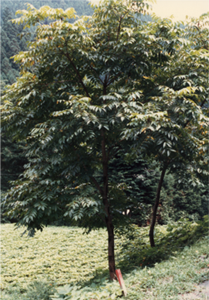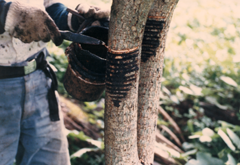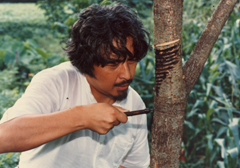
|
The recent discovery of "Sannaimaruyama" ruins, a trace of wood, proved that Urushi trees were planted in mountains around inhabited locations since the era of Joumon, 4000-5000 years ago. From the stratum of "Joumon" era, objects such as a red comb and pottery coated with the Urushi were excavated in almost perfect condition. Even after the long period of time, beyond our imagination, Urushi keeps objects brilliant. This power of Urushi, the life-force, makes us wonder; the beauty of Urushi is magnificent.
Urushi trees not only produce oxygen from solar energy by photosynthesis, but also produce the sap for natural resin paints.In the summer when the leaves grow thick and photosynthesis becomes most active, the sap of Urushi is collected from artificial scars made inside of the bark. The collected sap is then refined to make the natural resin paints, Urushi, the environmentally friendly products. Urushi dries in the atmosphere of around 25 degree, 70% humidity. The main ingredient, Urushiol, polymerize when it reacts to oxygen activated by the enzyme, laccase. Once dried, the Urushi surface provides a unique gentle feel of the material as well as its beautiful luster. The layer of Urushi is very strong, even resistant to acid or alkaline chemicals. Urushi has a superior capacity as a resin, and is suited for long-term use; the more you use it the more brilliant it shines, and after many years, Urushi gets clearer, while the color gets more brilliant (The only weakness is against UV rays; Urushi products should not be kept under the direct sun). On the other hand, synthetic resins, lacquer, dries when the solvent, paint thinner, volatilize, and they are used for consuming products of a short life circle. Today, humans rely on petroleum for producing energy and products, including lacquer or paint thinner, which in fact is one of the worst causes of global warming and serious destruction of the environment. In the English-Japanese dictionary, "Japan" is translated as "Nihon", "Urushi" and "lacquer ware", like "China" means porcelain in English. When Chinese potteries arrived in Europe, kings and feudal lords were fascinated by them and ordered alchemists to create porcelain, which in fact lead to the invention of "bone china". Similarly, during the Edo era, when Japanese black mirror-finish Urushi furniture made of "kuroroiro Urishi" arrived in Europe, it fascinated the kings and feudal loads of 18th century, and they ordered alchemists to imitate that, and that became the origin of the black lacquer mirror-finish of grand pianos. During the Edo period (1603-1867), the annual production of Urushi was about 2000 tons, but in 1867 Samurai and Shogun lost their power and a democratic parliamentary government took over, rapidly reducing the production of Urushi. During the Edo period, the production was promoted by the feudal clans, because of their need of arms and armour for Samurai, and furniture for Shogun and feudal lords. In 1960 when cheaper Urushi started to be imported, the annual production of Urushi dropped down to 20 tons annually. Today, 99% of Urushi consumption, 200 tons, is imported from China, and Japanese Urushi production is barely 1% (less than 2 tons). The principal production districts are the area of Johouji temple in Iwate prefecture and Daigo erea in Ibaragi prefecture. Japanese Urushi has the best quality, and is used mainly for luxury Urushi-ware due to the high cost; Japanese Urushi costs 10 times more than Chinese Urushi. Urushi-ware is considered to be too expensive for today’s consumer society. Due to the long process of production of Urushi and creation of Urushi-ware, it does not fit to the global standard of consumer’s needs and producer’s merits. While the use of Urushi is dropping down, imitation products coated with urethane, a synthetic resin made of petroleum, are replacing "Urushi-ware". It is deplorable that many consumers, especially Japanese children of today, do not know authentic Urushi. Less demand for expensive Japanese Urushi has put the traditional craftsmanship of collecting and refining the sap into a critical situation. The elevated age of the craftsmen, and the lack of successors to eventually replace them, puts the Japanese Urushi’s existence at risk. Presently, the issues of environmental disruption and global warming urge us to reclaim the society that fosters the gentle cycle of consumption: using natural products to create authentic articles for long-term use. Urushi Culture which once flourished during the Edo period is the perfect example of the energy saving, environmentally friendly production circle; planting Urushi trees, collecting and refining the sap (creating labor in the countryside), using natural products, and creating authentic articles to be used from generation to generation. Reclaiming the Urushi Culture would help to foster the gentle cycle of consumption. That is why I believe that manufacturers should use Japanese Urushi, and re-introduce authentic Urushi by creating Urushi products that fit today’s taste, sensitivity, and lifestyle. It is important for consumers to actually use authentic Urushi-ware to experience and know the specific gentle feel of the material and its beautiful luster. As a contemporary industrial artists, I've been particular about Japanese Urshi, producing contemporary original works without being limited to the tradition, including interior designing, Urushi Art and Urushi jewelries. I believe that it is my mission to introduce the beauty and wonder of the Japanese Urushi culture to the world and to the next generation. Industrial Artist / Artistic Craftsman Showzi Tsukamoto |

Urushi Tree |

Collecting Urushi sap |

Collecting Urushi sap |
|
|
(C)Copyright 2007-2009 ZIVACO Inc, All rights reserved.